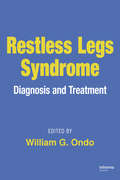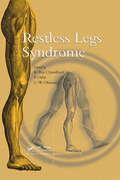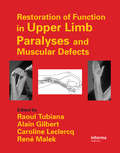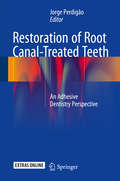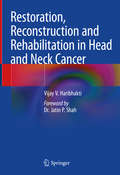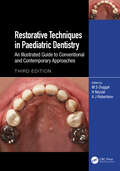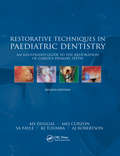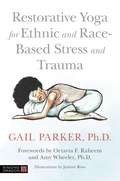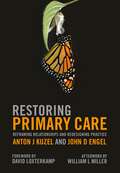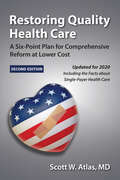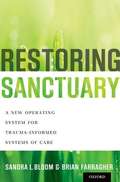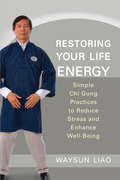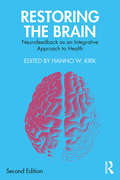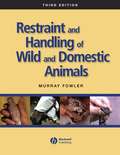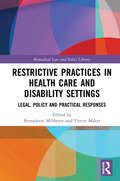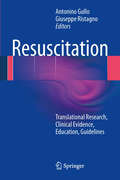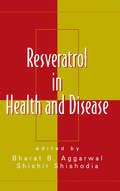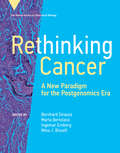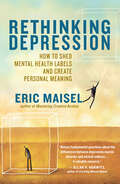- Table View
- List View
Restless Legs Syndrome: Diagnosis and Treatment
by William G. OndoThe most authoritative and comprehensive guide on RLS to date, this expertly written source examines the pathogenesis, diagnosis, and treatment of a condition affecting nearly 10% of the population. Ranging from basic science to therapeutics, Restless Legs Syndrome analyzes the many new and emerging medications impacting the management of this diso
Restless Legs Syndrome: Restless Legs Syndrome
by C. Warren Olanow K. Ray Chaudhuri Per OdinAlthough briefly covered in neurology texts, until now there has been no professional-level publication dedicated solely to restless legs syndrome (RLS). Most of what is available is either out-of-date or too general. Written by a panel of experts, Restless Legs Syndrome fills the void. Focusing on diagnosis and management, the authors discuss the
Restoration of Function in Upper Limb Paralyses and Muscular Defects
by Raoul Tubiana Alain Gilbert Caroline Leclercq René MalekRestoration of Functions in Upper Limb Paralyses and Muscular Defects provides the necessary information for the surgical management of muscular defects and neurobiological disorders of the upper extremity and details the restoration of essential functions in this area.This text examines:Upper extremity paralysis and muscular deficits Free muscle t
Restoration of Root Canal-Treated Teeth
by Jorge PerdigãoThis book offers a comprehensive and up-to-date overview of the restoration of teeth retained through root canal treatment, from the perspective of adhesive dentistry. The challenge of adhesion to root dentin is first explained and guidance provided on assessment of the restorability of endodontically treated teeth. The types of prefabricated passive post are then described in detail. The advantages and disadvantages of each type are outlined, with identification of the factors that influence post selection. Further topics include the ferrule effect, evidencebased clinical applications of fiber posts and new methods to lute fiber posts to the root canal without dentin adhesives. In addition, frequent myths are identified and dispelled. All aspects are illustrated with clinical and laboratory images, diagrams and high-resolution electron microscopy photographs.
Restoration, Reconstruction and Rehabilitation in Head and Neck Cancer
by Vijay V. HaribhaktiThis book offers a comprehensive set of principles that lead to ideal outcomes following treatment for Head and Neck Cancers, especially in those patients who need major reconstructive procedures. It goes beyond the scope of basic Head and Neck Cancer textbooks, or of reconstructive surgery texts, in that the essential focus is on optimal outcomes beyond fundamental evaluation and management. The book addresses a range of essential aspects: the chapters on Functional and Aesthetic considerations underscore crucial basics that should be understood by all surgeons, while other chapters relevant to all members of the Head and Neck team address Imaging, Robotics, Radiation Morbidities, Prosthetics and Quality of Life. Throughout the book, particular attention is given to high-quality photographs, flow diagrams and tables wherever possible, combined with crisp writing to achieve effective communication. The book is unique in the completeness of its approach: from the time of initial presentation, to the time patients resume their normal lives. Although written primarily for surgeons, its value extends to all members of the multi-disciplinary team managing Head and Neck Cancer patients today.
Restorative Just Culture in Practice: Implementation and Evaluation
by Sidney Dekker, Joseph Rafferty and Amanda OatesA restorative just culture has become a core aspiration for many organizations in healthcare and elsewhere. Whereas ‘just culture’ is the topic of some residual conceptual debate (e.g. retributive policies organized around rules, violations and consequences are ‘sold’ as just culture), the evidence base on, and business case for, restorative practice has been growing and is generating increasing, global interest. In the wake of an incident, restorative practices ask who are impacted, what their needs are and whose obligation it is to meet those needs. Restorative practices aim to involve participants from the entire community in the resolution and repair of harms. This book offers organization leaders and stakeholders a practical guide to the experiences of implementing and evaluating restorative practices and creating a sustainable just, restorative culture. It contains the perspectives from leaders, theoreticians, regulators, employees and patient representatives. To the best of our knowledge, there is no book on the market today that can function as a guide for the implementation and evaluation of a just and learning culture and restorative practices. This book is intended to fill this gap. This book will provide, among other topics, an overview of restorative just culture principles and practices; a balanced treatment of the various implementations and evaluations of just culture and restorative processes; a guide for leaders about what to stop, start, increase and decrease in their own organizations; and an attentive to philosophical and historical traditions and assumptions that underlie just culture and restorative approaches. The interest in ‘just culture’, not just in healthcare but also in other fields of safety-critical practice, has been steadily growing over the past decade. It is a trending area. In this, it has become clear that 20-year-old retributive models not only hinder the acceleration of performance and organizational improvement but have also in some cases become a blunt HR instrument, an expression of power over justice and a way to stifle honesty, reporting and learning. What is new in this, then, is the restorative angle on just culture, as it has been developed over the last few years and now is practised and applied to HR, suicide prevention, healthcare improvement, regulatory innovations and other areas.
Restorative Techniques in Paediatric Dentistry: An Illustrated Guide to Conventional and Contemporary Approaches
by H Nazzal M S Duggal A J RobertsonOne of the first books on the market to illustrate the various clinical techniques for restoration, this revised and updated new edition offers new material on treatment planning, local analgesia, biomaterials, biological and contemporary approaches, and aesthetic crowns. The book addresses the specific needs of the paediatric patient and helps the clinician manage the restoration with those needs in mind. As a classic volume, it is essential for every dentist working with children and adolescent patients.
Restorative Techniques in Paediatric Dentistry: An Illustrated Guide to the Restoration of Extensive Carious Primary Teeth
by M.S. Duggal M.E.J Cuzon S.A. Fayle K.J Toumba A.J. RobertsonThis was one of the first books on the market to illustrate the various clinical techniques for restoration, which is increasingly favored over extraction for primary teeth. A revised and updated edition of this successful text offers, in addition, new material on plastic restorations. Restorative Techniques addresses the specific needs of the pediatric patient, and it helps the clinician manage the restoration with those needs in mind. As a classic volume, it is essential for every dentist, particularly those who work with children and adolescents and particularly those who perform restorative dentistry.
Restorative Yoga for Ethnic and Race-Based Stress and Trauma
by Gail ParkerPresenting ways in which Restorative Yoga can contribute to healing emotional wounds, this book invites yoga teachers, therapists and practitioners to consider the psychological impact of ethnic and race-based stress and trauma. It aids in the process of uncovering, examining, and healing one's own emotional wounds and offers insight into avoiding wounding or re-wounding others. The book describes how race-based traumatic stress differs from PTSD and why a more targeted approach to treatment is necessary, as well as what can trigger it. It also considers the implications of an increasingly racially and ethnically diverse and global yoga community, as well as the importance of creating conscious yoga communities of support and connection, where issues of race and ethnicity are discussed openly, non-defensively and constructively.By providing a therapeutic structure that assists those directly and indirectly impacted by ethnic and race-based stress and trauma, Restorative Yoga for Ethnic and Race-Based Stress and Trauma provides valuable tools for aiding in the processing of stressful experiences and in trauma recovery.(P)2021 Hodder & Stoughton Limited
Restorative Yoga for Ethnic and Race-Based Stress and Trauma: A Visual Introduction (Therapeutic Parenting Bks.)
by Gail ParkerPresenting ways in which Restorative Yoga can contribute to healing emotional wounds, this book invites yoga teachers, therapists and practitioners to consider the psychological impact of ethnic and race-based stress and trauma. It aids in the process of uncovering, examining, and healing one's own emotional wounds and offers insight into avoiding wounding or re-wounding others. The book describes how race-based traumatic stress differs from PTSD and why a more targeted approach to treatment is necessary, as well as what can trigger it. It also considers the implications of an increasingly racially and ethnically diverse and global yoga community, as well as the importance of creating conscious yoga communities of support and connection, where issues of race and ethnicity are discussed openly, non-defensively and constructively.By providing a therapeutic structure that assists those directly and indirectly impacted by ethnic and race-based stress and trauma, Restorative Yoga for Ethnic and Race-Based Stress and Trauma provides valuable tools for aiding in the processing of stressful experiences and in trauma recovery.
Restorative cities: urban design for mental health and wellbeing
by Jenny Roe Layla McCayOvercrowding, noise and air pollution, long commutes, and lack of daylight can take a huge toll on the mental well-being of city-dwellers. With mental healthcare services under increasing pressure, could a better approach to urban design and planning provide a solution? The restrictions faced by city residents around the world during the COVID-19 pandemic has brought home just how much urban design can affect our mental health – and created an imperative to seize this opportunity. Restorative Cities explores a new way of designing cities, one that places mental health and wellness at the forefront. Establishing a blueprint for urban design for mental health, it examines a range of strategies – from sensory architecture to place-making for creativity and community – and brings a genuinely evidence-based approach that will appeal to designers and planners, health practitioners and researchers alike - and provide compelling insights for anyone who cares about how our surroundings affect us. Written by a psychiatrist and public health specialist, and an environmental psychologist with extensive experience in architectural practice, this much-needed work will prompt debate and inspire built environment students and professionals to think more about the positive potential of their designs for mental well-being.
Restoring Primary Care: Reframing Relationships and Redesigning Practice
by John D Engel Anton J KuzelTo many practitioners, managers and patients, US primary care is in crisis. Primary care physicians are often overworked and undervalued, and both patients and care providers can feel locked into structures that lack compassion and are unfit for their intended purposes. Healthcare reforms aim to resolve the situation, but changes may take years to deliver and are contingent on numerous outside factors. What steps are within care providers' power to take now? This book lays out a course to deliver compassionate care, quality, and efficiency that - unlike many current patient-centred medical home initiatives in the US - does not require outside funding. After reflecting on avoidable problems and harms in primary care, the book offers stories of hope from innovative clinicians across the US before presenting ten practical, deliverable steps to lift primary care provision from 'poor' or 'mediocre' to 'great'. This book will be of interest to practicing family physicians and general internists, but will also be useful reading for health system leaders, healthcare insurance purchasers and insurance company executives.
Restoring Quality Health Care: A Six-Point Plan for Comprehensive Reform at Lower Cost
by Scott W. AtlasThe Affordable Care Act (ACA) granted the federal government unprecedented regulatory authority over health insurance and the health care industry. Those changes ignore the fundamental problems with the existing system: the incentives that have caused runaway costs and excluded millions of Americans from accessing the world's best medical care. Many former ACA supporters now push for an even more extreme takeover of the US system: overt single-payer health care, or “Medicare for All.”In Restoring Quality Health Care, Dr. Scott W. Atlas offers a fundamentally different approach to improving America's health care system. Instead of framing the debate with the traditional trade-offs—fewer benefits versus higher taxes—his plan is modeled around a new paradigm: restoring the appropriate market-based incentives to increase the quality of health care and reduce its costs. He proposes a six-point reform plan for US health care centering on lower-cost catastrophic coverage and universal, significantly expanded health savings accounts (HSAs). The plan transforms the US health care system and enhances innovation by instilling market-based competition and empowering consumers through incentives and strategic deregulation. Most important, the health care reforms in this plan reflect the key principles held by Americans concerning what they value and expect from health care in terms of access, choice, and quality.
Restoring Sanctuary: A New Operating System for Trauma-Informed Systems of Care
by Sandra L. Bloom Brian FarragherThis is the third in a trilogy of books that chronicle the revolutionary changes in our mental health and human service delivery systems that have conspired to disempower staff and hinder client recovery. Creating Sanctuary documented the evolution of The Sanctuary Model therapeutic approach as an antidote to the personal and social trauma that clients bring to child welfare agencies, psychiatric hospitals, and residential facilities. Destroying Sanctuary details the destructive role of organizational trauma in the nation's systems of care. Restoring Sanctuary is a user-friendly manual for organizational change that addresses the deep roots of toxic stress and illustrates how to transform a dysfunctional human service system into a safe, secure, trauma-informed environment.
Restoring Your Life Energy: Simple Chi Gung Practices to Reduce Stress and Enhance Well-Being
by Waysun LiaoIn our busy lives we are bombarded by energy that taxes us and depletes our chi. This book of simple movements and meditations drawn from the Chinese arts of t'ai chi and chi gung will help restore your life energy, known as chi. Chi, according to traditional Chinese medicine, is the fuel and essence that connects body, mind, and spirit, and without it we fall apart physically, mentally, and spiritually. In Restoring Your Life Energy, well-known and respected t'ai chi master Waysun Liao explains why protecting our chi is so important, how chi gets taxed and damaged in our lives, and how to restore it. He explains: * The three levels of healing--physical, mental, and energetic/spiritual: what they are, why it is important to understand them, and how to target our practice to address each level; * Moving meditation, a powerful way of restoring chi (once we learn to sense the flow of chi, we can actually direct healing chi energy to areas in our body that need attention); * And how to integrate our knowledge of chi with conventional advice regarding diet, exercise, and medication. The book includes numerous exercises including "exercises for daily life," simple breathing and sensory meditations that can be done throughout the day; more advanced breathing and sensory meditations; standing exercises to move internal energy; "cleansing forms" to do during times of stress; and deeply cleansing and restorative "Tao gong" exercises.
Restoring the Brain: Neurofeedback as an Integrative Approach to Health
by Hanno W. KirkThis thoroughly updated second edition of Restoring the Brain is the definitive book on the theory and the practice of Infra-Low Frequency brain training. It provides a comprehensive look at the process of neurofeedback within the emerging field of neuromodulation and essential knowledge of functional neuroanatomy and neural dynamics to successfully restore brain function. Integrating the latest research, this thoroughly revised edition focuses on current innovations in mechanisms-based training that are scalable and can be deployed at any stage of human development. Included in this edition are new chapters on clinical data and case studies for new applications; using neurofeedback for early childhood developmental disorders; integrating neurofeedback with psychotherapy; the impact of low-frequency neurofeedback on depression; the issue of trauma from war or abuse; and physical damage to the brain. Practitioners and researchers in psychiatry, medicine, and behavioral health will gain a wealth of knowledge and tools for effectively using neurofeedback to recover and enhance the functional competence of the brain.
Restraint and Handling of Wild and Domestic Animals
by Murray FowlerRestraint and Handling of Wild and Domestic Animals, Third Edition offers an introduction to the basic principles of animal restraint and an overview of techniques for vertebrate wild and domestic animals. Fully updated throughout, the third edition also includes new chapters on understanding behavior, training for restraint and handling, and animal welfare and restraint. Now in full color, the third edition of this classic reference is an invaluable tool to recognizing potential danger in restraint and reducing stress in the animal.
Restrictive Practices in Health Care and Disability Settings: Legal, Policy and Practical Responses (Biomedical Law and Ethics Library)
by Bernadette McSherryThis volume explores different models of regulating the use of restrictive practices in health care and disability settings. The authors examine the legislation, policies, inspection, enforcement and accreditation of the use of practices such as physical, mechanical and chemical restraint. They also explore the importance of factors such as organisational culture and staff training to the effective implementation of regulatory regimes. In doing so, the collection provides a solid evidence base for both the development and implementation of effective approaches to restrictive practices that focus on their reduction and, ultimately, their elimination across health care sectors. Divided into five parts, the volume covers new ground in multiple respects. First, it addresses the use of restrictive practices across mental health, disability and aged care settings, creating opportunities for new insights and interdisciplinary conversations across traditionally siloed sectors. Second, it includes contributions from research academics, clinicians, regulators and mental health consumers, offering a rich and comprehensive picture of existing regulatory regimes and options for designing and implementing regulatory approaches that address the failings of current systems. Finally, it incorporates comparative perspectives from Australia, New Zealand, the Netherlands, Germany and England. The book is an invaluable resource for regulators, policymakers, lawyers, clinicians, consumer advocates and academics grappling with the use and regulation of restrictive practices in mental health, disability and aged care contexts.
Restructuring Canada's Health Systems: Proceedings of the Fourth Canadian Conference on Health Economics
by Raisa Deber Gail ThompsonIs the Canadian health care system becoming a victim of its own success? It has done what it set out to do – provide universal access to all medically necessary health services without financial barriers to patients – but expanding technology, an aging population, and escalating costs strain its ability to continue. It is time to explore ways to reorient and restructure the health care system and the services it provides. At the Fourth Canadian Conference on Health Economics, contributors of international reputation addressed these concerns. Their papers, collected in this volume, consider a wide range of fundamental issues related to health care policies and structures. They discuss new developments in health care delivery, assess implications of such new policies as home care and health promotion, and propose concrete alternatives for restructuring the present system to sustain universal medicine.
Resuscitation
by Antonino Gullo Giuseppe RistagnoResuscitation is a two-stage process comprising the achievement/maintenance of spontaneous circulation and post-resuscitation management. The approach is complex and multifaceted and entails the integration of new physiological insights, pharmacological options, and technological advances. The purpose of this volume, written by top experts in the field, is to promote, share, and disseminate new advances in resuscitation and post-resuscitation care. The issues addressed are wide ranging and of great topical interest or controversy. They include priorities of intervention, quality of resuscitation, use of mechanical supports, new defibrillation strategies, prevention of organ damage, strategies in cases of sudden cardiac death, new pharmacological treatments, and post-resuscitation care, including temperature management and prediction and improvement of outcome after cardiac arrest. Particular attention is devoted to up-to-date evidence from the most recent experimental and clinical trials on resuscitation science and to gold standard evidence-based resuscitation and post-resuscitation treatments and interventions. In addition, organizational models and integrated care systems for trauma are considered, and critical care education and the process of guideline development are reviewed.
Resveratrol in Health and Disease (Oxidative Stress And Disease Ser.)
by Bharat B. Aggarwal Shishir ShishodiaPracticing evidenced-based medicine some 25 centuries ago, Hippocrates proclaimed "Let food be thy medicine and medicine be thy food." This advice parallels the common American saying, "You are what you eat," and is supported by a National Institute of Health recommendation to consume as many as eight servings of fruits and vegetables daily to prev
Rethinking AGING
by Nortin M. HadlerFor those fortunate enough to reside in the developed world, death before reaching a ripe old age is a tragedy, not a fact of life. Although aging and dying are not diseases, older Americans are subject to the most egregious marketing in the name of "successful aging" and "long life," as if both are commodities. InRethinking Aging, Nortin M. Hadler examines health-care choices offered to aging Americans and argues that too often the choices serve to profit the provider rather than benefit the recipient, leading to the medicalization of everyday ailments and blatant overtreatment. Rethinking Agingforewarns and arms readers with evidence-based insights that facilitate health-promoting decision making. Over the past decade, Hadler has established himself as a leading voice among those who approach the menu of health-care choices with informed skepticism. Only the rigorous demonstration of efficacy is adequate reassurance of a treatment's value, he argues; if it cannot be shown that a particular treatment will benefit the patient, one should proceed with caution. InRethinking Aging, Hadler offers a doctor's perspective on the medical literature as well as his long clinical experience to help readers assess their health-care options and make informed medical choices in the last decades of life. The challenges of aging and dying, he eloquently assures us, can be faced with sophistication, confidence, and grace.
Rethinking Cancer: A New Paradigm for the Postgenomics Era (Vienna Series in Theoretical Biology)
by Bernhard Strauss, Marta Bertolaso, Ingemar Ernberg, and Mina J. Bissell et al.Leading scientists argue for a new paradigm for cancer research, proposing a complex systems view of cancer supported by empirical evidence.Current consensus in cancer research explains cancer as a disease caused by specific mutations in certain genes. After dramatic advances in genome sequencing, never before have we known so much about the individual cancer cell--and yet never before has it been so unclear what to do with this knowledge. In this volume, leading researchers argue for a new theory framework for understanding and treating cancer. The contributors propose a complex systems view of cancer, presenting conceptual building blocks for a new research paradigm supported by empirical evidence.The contributors first discuss the new research framework in terms of theoretical foundations and then take up the relevance of a systems approach, reviewing such topics as nonlinearity, recurrence after treatment, the cellular attractor concept, network theory, and non-coding DNA--the "dark matter" of our genome. They address the temporality of cancer progression, drawing on evolutionary theory and clinical experience. Finally, they cover the dominant role of the tissue microenvironment in cancer, analyzing topics including altered metabolic pathways, the disease-defining influence on metastasis, and the interconnectedness of different environmental niches across levels of organization.
Rethinking Causality, Complexity and Evidence for the Unique Patient: A CauseHealth Resource for Healthcare Professionals and the Clinical Encounter
by Rani Lill Anjum Samantha Copeland Elena RoccaThis open access book is a unique resource for health professionals who are interested in understanding the philosophical foundations of their daily practice. It provides tools for untangling the motivations and rationality behind the way medicine and healthcare is studied, evaluated and practiced. In particular, it illustrates the impact that thinking about causation, complexity and evidence has on the clinical encounter. The book shows how medicine is grounded in philosophical assumptions that could at least be challenged. By engaging with ideas that have shaped the medical profession, clinicians are empowered to actively take part in setting the premises for their own practice and knowledge development. Written in an engaging and accessible style, with contributions from experienced clinicians, this book presents a new philosophical framework that takes causal complexity, individual variation and medical uniqueness as default expectations for health and illness.
Rethinking Depression: How to Shed Mental Health Labels and Create Personal Meaning
by Eric MaiselIn this provocative and pathbreaking distillation of a career spent working with individuals seeking help with mood and motivation, Eric Maisel reveals the implications of one of the most dramatic cultural shifts of our time. In recent decades, much of the unhappiness inherent in the human condition has been monetized and labeled as the disease of depression and related “disorders.” Maisel persuasively critiques this sickness model and prescribes a potent new therapy. The existential cognitive-behavioral therapy (ECBT) he details here marries the proven methods of CBT with the powerful meaning-based orientation of existential therapy. The result is a revolutionary reimagining of life’s difficulties and a liberating model of self-care that optimizes the innate human ability to create meaning and seize opportunity — in any circumstance.
